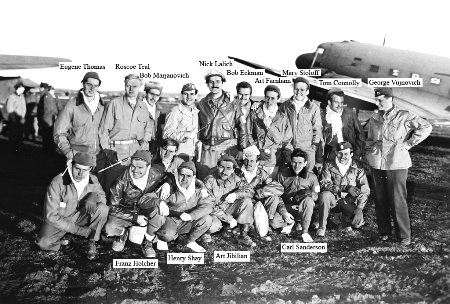Canton man a big part of greatest untold story of WWII
By Jay TurnerIf it weren’t for 95-year-old George Vujnovich receiving his long-overdue Bronze Star last month — a full 66 years after he helped launch the incredible, yet thoroughly overlooked Halyard rescue mission in Nazi-occupied Yugoslavia in the late summer of 1944 — then perhaps Paul Seery’s thoughts would be elsewhere this Veterans Day.

Tom Connolly and his crew celebrate on Italian soil after being rescued from Nazi-occupied Yugoslavia in late December of 1944. Also pictured are OSS agents George Vujnovich and Nick Lalich.
Instead, they are fixed firmly on the memory of his old friend and former coworker at Emerson and Cuming, the late Tom Connolly, whose stories of rescue and adventure as a crew member on a B24 bomber had always fascinated Seery during their time together at the Canton-based chemical plant throughout the 1960s and early 1970s.
Seery, who is now retired and living in Canton, said it had been years since he had thought of those stories when, seemingly out of nowhere, he came across this article about Vujnovich in the Boston Globe, and suddenly it dawned on him why it all sounded so familiar: Vujnovich’s mission had rescued his old pal Tom.
It wasn’t just Connolly, however. As it turns out, and as Seery soon recalled from his days at Emerson and Cuming, Operation Halyard was massive; in fact, it was arguably the greatest rescue mission of World War II, not to mention the largest air rescue of Americans behind enemy lines in any war, with more than 500 downed pilots rescued — without a single loss of life — between early August and late December of 1944.
Most of the airmen, including Connolly, had been shot down over Serbia while on bombing runs to the German-occupied Ploesti oil fields in Romania. They spent the next several months hiding out in farmhouses, aided by Serbian farm families and protected by Serbian Chetnik guerillas, who were led by General Draza Mihailovich.
Vujnovich, a Serbian American working in the Office of Strategic Services (OSS), a precursor to the CIA, was the one who convinced American officials to carry out the rescue mission. It was an elaborate plan — one that involved dropping OSS agents into enemy territory, then building makeshift airstrips on mountainous terrain before sending in a fleet of C-47 cargo planes to pick up the stranded soldiers — and yet it was a total success.
“It’s such a fantastic story,” noted Seery, who has spent the past few weeks learning as much as he can about the mission, even searching local libraries for The Forgotten 500, a complete history of the rescue by Gregory A. Freeman.
Of course, the average American knows little, if anything at all, about Operation Halyard, because the mission was kept secret by the United States military for decades. And the reason, as Seery is quick to point out, has everything to do with the politics of the time, most notably the British and Americans’ waning support for Mihailovich and the Chetniks in favor of a rival faction, headed by the communist leader Tito.
Meanwhile, as the communists gained control over Yugoslavia, the credit for the rescue went to Tito and his forces, while Mihailovich was portrayed as a Nazi sympathizer and put on trial for war crimes in 1946. In America, many of the former airmen went to great lengths to clear Mihailovich’s name, even making a highly publicized trip to Washington, D.C. in an effort to declassify the documents detailing the rescue mission; however, on July 17 of that year, Mihailovich was executed by firing squad and buried in an unmarked grave.
Even to this day, Seery remembers the anger and resentment Connolly harbored, not only toward Tito, but also toward the U.S. government for not doing more to protect his hero.
“Tom and his crew even wanted to go back to Serbia and testify for Mihailovich, and the U.S. State Department wouldn’t let them go,” said Seery. “It’s a shame — one of the greatest rescue missions of the war, and all these years the truth had been kept under wraps.”
Seery also has more than just his memory to rely on. Besides conducting his own research, he recently reached out to one of Tom’s two sons, Ted Connolly, who has in his possession a veritable treasure chest of historical documentation on his father’s wartime experiences, including dozens of photographs and letters — and even a few weapons.
Ted, who grew up in a house on Pleasant Circle and attended Canton schools, remembers hearing the stories as a kid — of his father’s crew being shot down over Yugoslavia and the Chetniks helping them out. He was also keenly aware of the “disappointment in [his father’s] heart over Mihailovich being sold down the river.”
At the same time, Ted said his appreciation for the Halyard mission and his father’s role in it has grown exponentially over the years, especially as he has gotten to know various members of his dad’s crew, and in some cases, the children of crew members. He also could not say enough about Freeman’s book, The Forgotten 500, which, much to Ted’s surprise, included pictures of his father in Yugoslavia that he had never before seen.
(Click on Page 2 below to continue reading)
Page 1 Page 2
Short URL: https://www.thecantoncitizen.com/?p=1728










